Traders work on the floor of the New York Stock Exchange on Sept. 30th, 2025.
NYSE
Stock futures dropped on Wednesday after the U.S. government shut down at midnight, raising fears of a longer-than-normal stoppage that weighs on an already fragile economy. Futures continued their declines after the latest ADP report showed a surprise decline jobs for September.
Futures tied to the Dow Jones Industrial Average fell 119 points, or 0.3%, with the major average set to retreat from a record close posted on the previous trading day. S&P futures and Nasdaq 100 futures declined 0.4% and 0.5%, respectively. Markets are coming off a banner month that saw the S&P 500 rise more than 3.5%.
On Wednesday, data from processing firm ADP showed that private payrolls fell by 32,000 last month, well below the gain of 45,000 that economists polled by Dow Jones had estimated. This reading, which signifies the biggest drop since March 2023, takes on even greater importance now that there’s an economic data blackout because of the shutdown.
The U.S. government shut down after attempts made by the Republican-controlled Senate to secure a temporary spending bill failed on Tuesday. Democrats are hoping to use the measure to codify an extension of health care tax credits for millions of Americans.
The stock market has typically glided through previous government shutdowns — but this one could be riskier, given the slew of economic factors at play. Investors remain concerned about a slowing labor market and inflation risks as well as historically elevated stock valuations and market concentration levels.
The nonpartisan Congressional Budget Office estimated Tuesday that the shutdown will result in the furlough of about 750,000 federal employees. Trump has threatened permanent mass firings of federal workers under a shutdown, adding a new economic risk to this stoppage.
This time around, the market is likely to focus on the length of the shutdown since a prolonged closure could delay key economic data ahead of the Federal Reserve’s meeting in late October. The Labor Department said Friday it will shut down virtually all activity, meaning the September nonfarm payrolls report would not be released at the end of the week.
The shutdown means the Fed will be partially flying blind with investors expecting the central bank’s second rate cut of the year later this month and another decrease in December. Wednesday morning’s ADP data likely keeps the Fed on track for an October rate cut.
Bank stocks fell broadly in the premarket follow the stoppage on concern about a slowing economy. JPMorgan Chase, Citigroup and Wells Fargo each shed nearly 1%. Goldman Sachs and Morgan Stanley were also lower. Tech shares that have led the bull market, including Palantir and Oracle, declined as part of a risk-off move.
“The market seemed to be looking for a reason to sell off after bucking the seasonal weakness we tend to experience in September,” said Jay Woods, chief market strategist for Freedom Capital Markets. “While the shutdown was expected, the lack of progress and urgency to a resolution has investors concerned. The backdrop to this shutdown is much different than the 2018 shutdown, which was the longest on record.”
Gold hit a new record as investors looked for a global safe haven. Bitcoin also gained. Treasury yields declined on the weak reading from ADP.
